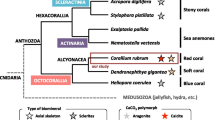Summary
Calcified demosponges (coralline sponges, sclero-sponges), the first metazoa producing a carbonate skeleton, used to be important reef building organisms in the past. The relatives of this group investigated here,Spirastrella (Acanthochaetetes) wellsi, Astrosclera willeyana andVaceletia cf.crypta, are restricted to cryptic niches of modern Pacific coral reefs and may be considered as “living fossils’. They are characterized by a basic biologically controlled metazoan biomineralization process. Each of the investigated taxa forms its calcareous basal skeleton in a highly specialized way. Moreover, each taxon secretes distinct Ca2+-binding macromolecules which were entrapped within the calcium carbonate crystals during skeleton formation. Therefore these Ca2+-binding macromolecules were also described as intracrystalline macromolecules. When isolated and separated by SDS polyacrylamide gel electrophoresis, the organic skeleton matrix of the three species revealed to be composed of a respective distinct array of EDTA-soluble proteins. A single protein of 41 kDa was detected inS. wellsi, two proteins of 38 and 120 kDa inA. willeyana, and four proteins of 18 kDa, 30 kDa, 33 kDa, and 37 kDa inVaceletia sp. When run on IEF gel, the Ca2+-binding proteins gave staining bands at pH values between 5.25 and 5.65. As proved by anin vitro mineralization assay, the extracted proteins effectively inhibit CaCO3 and SrCO3 precipitation, respectively, in a saturated solution. Biochemical properties and behavior of the extracted proteins strongly suggest that they are involved in crystal nucleation and skeleton carbonate formation within the calcified sponges studied here.
Similar content being viewed by others
References
Addadi, L. and Weiner S (1985): Interactions between acidic proteins and crystals: Stereochemical requirements in biomineralization. —Proc. Natl. Acad. Sci.82, 4110–4114.
Ayling, A. (1982): Redescription ofAstrosclera willeyana Lister 1900 (Ceratoporellida, Demospongiae), a new record from the Great Barrier Reef.—Mem. Nat. Mus. Victoria, Sydney43, 99–103.
Cariolou, M.A. and Morse, D.E. (1988): Purification and characterization of calcium-binding conchiolin shell peptides from mollucs,Haliotis rufescens, as a function of development.—J. Comp. Physiol., B157, 717–729.
Dauphin, Y. (1996): The organic matrix of coleoid cephalopod shells: molecular weights and isoelectrical properties of the soluble matrix in relation to biomineralization processes.— Mar. Biol.125, 525–529.
Degens, E.T. Spencer, D. W. and Parker, R.H. (1967). Paleobiochemistry of molluscan shell proteins.—Comp. Biochem. Physiol.20, 533–579.
Falini, G., Albeck, S., Weiner, S. and Addadi, L. (1996): Control of aragonite or calcite polymorphism by mollusk shell macro-molecules. —Ê≈ience,271, 67–69.
Fritz, M., Belcher, A.M., Radmacher, M., Walters, D.A., Hansma, P.K., Stucky, G.D., Morse, D.E. and Mann, S. (1994): Flat pearls from biofabrication of organized composites on inorganic substrates.—Nature,371, 49–51.
Gautret, P. (1990): Recherche sur les modalités de la biominéralisation carbonatée chez les Démosponges actuelles et fossiles. Implications phylogénétiques et paléobiologiques.—Thèse Univerité Paris-Sud, Orsay, France.
Hare, P. E. (1963): Amino acids in the proteins from aragonite and calcite in the shells of Mytilus californicus.—Science,139, 216–217.
Hartman, W.D. and Goreau, T.F. (1975): A pacific tabulate sponge, living representative of a new order of Sclerosponges.— Postilla,167, 1–21.
Heukeshoven, J. and Dernick, R. (1985): Simplified method for silver staining of proteins in polyacrylamide gels and the mechanism of silver staining.—Electrophoresis,6, 103–112.
Hincke, M.T., Tsang, C.P., Courtney M., Hill, V. and Narbaitz, R. (1995): Purification and immunochemistry of a soluble matrix protein of the chicken eggeshell (Ovocleidin 17).—Calcif. Tissue. Int.,56, 578–583.
Laemmli, U.K. (1970): Cleavage of structural proteins during the assembly of the head of bacteriophage T4.—Nature,227, 680–685.
Lowenstamm, H.A. (1981): Minerals formed by organisms.— Science,211, 1126–1131.
Lowenstamm, H.A. and Weiner, S. (1989): On Biomineralization. —Oxford, UK (Oxvord Univ. Press)
Punzi, J.S. and DenBesten, P.K. (1995): Purification of nonamelogenin protein from bovine secretory enamel.—Calcif. Tissue Int.,57, 379–384.
Reitner, J. (1992): “Coralline Spongien”—Der Versuch einer phylogenetisch-taxonomischen Analyse.—Berliner Geowiss. Abh., E1, 1–352, Berlin.
Reitner, J. (1993). Modern cryptic microbialite/metazoan facies from Lizard Island (Great Barrier Reef, Australia). Formation and concepts.—Facies,29, 3–40.
Reitner, J. and Engeser, T. (1987): Skeletal structures and habitats of recent and fossilAcanthochaetetes (subclass Tetractinomorpha, Demospongiae, Porifera).—Coral Reefs,6, 13–18.
Reitner, J. and Gautret, P. (1996): Skeletal formation in the modern but ultraconservative chaetetid spongeSpirastrella (Acanthochaetetes) wellsi (Desmospongiae, Porifera).—Facies,34, 193–208.
Reitner, J., Wörheide, G., Lange R. and Thiel, V. (1997): Biomineralization of calcified skeletons in three Pacific coralline demonsponges—an approach to the evolution of basal skeleton. —Cour. Forsch.-Inst. Senckenberg,201, 371–383.
Smith, P.K., Krohn, R.I., Hermanson, G.T., Mallia, A.K., Gartner, F.H., Provenzano, M.D., Fujimoto, E.K., Goeke, N.M., Olson, B.J. and Klenk, D.C. (1985): Measurement of protein using bicinchonic acid.—Analytical Biochemistry,150, 76–85.
Weiner, S. and Hood, L. (1975): Soluble protein of the organic matrix of mollusk shells: a potential template for shell formation. —Science,190, 987–989.
Wheeler, A.P., George, J.W., and Evans, C.A. (1981): Control of calcium carbonate nucleation and crystal growth by soluble matrix of oyster shell.—Science,212, 1397–1398.
Wörheide, G. and Reitner, J. (1996): “Living fossil” spinctozoan coralline sponge colonies in the shallow water caves of the Osprey Reef (Coral See) and the Astrolabe Reefs (Fiji Islands). —In: Reitner, J., Neuweiler, F., Gunkel, F. (eds), Global and Regional Controls on Biogenic Sedimentation. I. Reef Evolution. —Gött. Arb. Geol. Paläont. spec. vol.2, 145–148.
Wörheide, G., Reitner, J. and Gautret, P, (1997): Comparison of Biocalcification in the two coralline Demosponges Astrosclera willeyana Lister 1900 and“Acanthochaetetes” wellsi Hartman and Goreau 1975.—Proc 8th Int. Coral Reef Sym.,2, 1427–1432.
Wörheide, G. (1998): The Reef Cave Dwelling Ultraconservative Coralline DemospongeAstrosclera willeyana Lister 1900 from the Indo-Pacific.—Facies,38, 1–88.
Author information
Authors and Affiliations
Corresponding author
Rights and permissions
About this article
Cite this article
Lange, R., Bergbauer, M., Szewzyk, U. et al. Soluble proteins control growth of skeleton crystals in three coralline demosponges. Facies 45, 195–201 (2001). https://doi.org/10.1007/BF02668112
Received:
Revised:
Issue Date:
DOI: https://doi.org/10.1007/BF02668112




